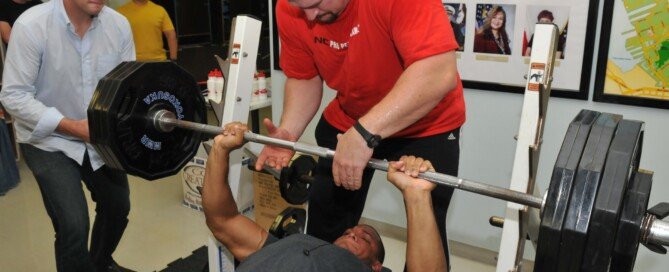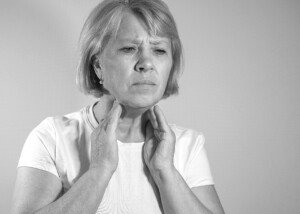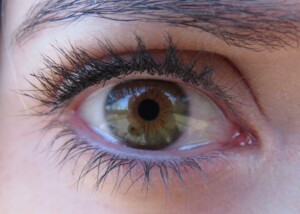Can Bench Press Spotter Catch Dropped Barbell from Suicide Grip?
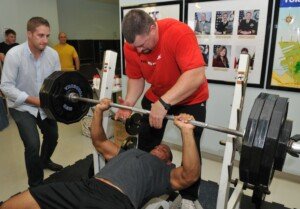
It’s crazy that people actually think that a spotter can CATCH a barbell in free-fall after it drops from a suicide grip!
Have these ding-dongs ever spotted?
I was inspired to write this article after reading the dopey comments to a news story about Kyle Thomson, 22, of Iowa State who was bench pressing 315 pounds when the barbell suddenly fell from his hands and fatally crushed his neck.
Reportedly there were “spotters” present when the “barbell slipped from the member’s hands.”
The only logical explanation for the slip is the suicide grip (thumbless, just using the palm to support the bar).
The story garnered nearly a hundred comments (excluding replies to them). I just could not believe how many people posted comments to the effect of:
• “Why weren’t the spotters doing their job?”
• “Isn’t a spotter supposed to prevent the barbell from falling?”
• “What’s the point of having spotters if they can’t help?”
• “What were the spotters doing when the barbell fell?”
• “Weren’t the spotters paying attention?”
These commenters do not have to have bench pressing or spotting experience to know how utterly impossible it would be for a person to catch a 315 pound barbell in mid-air that unexpectedly and instantly slips out of the user’s suicide grip.
This is NOT the same as the athlete suddenly wavering and pausing, with the barbell still in their hands.
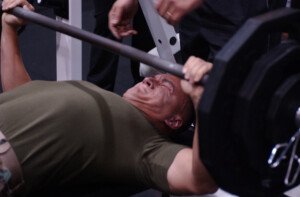
This far more common scenario gives a spotter plenty of reaction time to grab the bar and, with the athlete’s hands still on it, help him or her lift it back up and rack it.
When I was a personal trainer at a gym, I had male (and female) clients, and I spotted them for heavy lifts.
Of course, I did not permit the suicide grip, so it would’ve been impossible for the bar to suddenly slip out of their hands and free fall.
But I was always prepared for a sudden loss of control of the bar. And that happened. And I helped pull it back up without incident.
But that kind of spotting is not the same as the bar actually disconnecting from the hands and free-falling towards (and onto) the person’s chest or neck.
Even if you KNOW that in three seconds, the barbell is going to drop, you will NOT be able to catch it before it makes contact with the athlete’s neck or chest if you’re standing behind the athlete’s head.
Unless the bar weighs 45 pounds. Maybe 75. But not 315!
Basic Physics of a Free-Falling Object
When an object starts falling, it accelerates at 32 feet per second squared.
If an object is dropped from a point high enough above you, you can catch it. But what if you’re standing over someone as a spotter who’s bench pressing?
The distance you’d be working with to catch the weight is however many inches are between the barbell and the athlete’s neck or chest.
Unless you live in an accelerated time frame like the Scalosians did on the classic “Star Trek” episode called “Wink of an Eye,” you are not going to process the movement of that falling weight fast enough to catch it within such a confined vertical space.
Oh, unless you’re Superman, of course, who can see the movement of bullets and intercept them.
But let’s suppose you COULD react fast enough.
You STILL would not be able to catch a 315 pound barbell from the position of a spotter!
The spotter is standing behind the head of the athlete and slightly bent over, hands hovering over the bar or under it.
The bar slips from the suicide grip. The spotter grabs it when it’s fallen only four inches (assume the spotter has the Scalosians’ abilities — they see everything in super slow motion).
Tell me, just how is a person — even the strongest man in the gym — going to support the weight of 315 pounds in his position of standing bent over the bar?
Do you realize how much strength this would require?
Being able to bench press and deadlift 315 pounds does NOT mean you can hold this weight in mid-air after catching it with bent arms from a slightly bent-over position.
What about a spotting duo stationed on either side of the barbell?
Though both men would have the strength to control a very heavy barbell, the problem would be their reaction time as it suddenly and unexpectedly free-falls from a suicide grip.
They wouldn’t be able to react quickly enough to grab it before it struck the athlete’s body.
Go ahead, try it: Stand in the spotter’s position at a bench press station and see if you can pick a 315 pound barbell off the rack from such a biomechanically compromised position.
You won’t get it up even an inch. If you can’t do this, you can’t catch it in mid-air, either.
So what good is a spotter for a bench press then?
• Help the athlete get the bar off the rack and back on the rack.
• Add help when the lifter is struggling to push the bar back up.
• Assist in the lowering of the bar; the spotter’s hands are around the bar, pulling it upward to subtract weight.
This upward pull may be only 10 pounds of force, but that’s all that may be needed.
A spotter is NOT able to catch a barbell in mid-air and hold it there.
Once again, a barbell that slips out of the athlete’s suicide grip is going to hit his neck or chest before the spotter knows what’s happening.
In the case of a suicide grip, this happens in a second. In the case of cramping, fatiguing arms, the lifter is able to say, while still somewhat controlling the weight, “Take it! Take it!” or some other warning.
The spotter can grab it and, with the fatigued lifter’s help, both can set it back on the rack.
This is not a slip. This is not a drop. There is no free-fall. The suicide grip in the bench press is aptly named.
 Lorra Garrick is a former personal trainer certified through the American Council on Exercise. At Bally Total Fitness she trained women and men of all ages for fat loss, muscle building, fitness and improved health.
Lorra Garrick is a former personal trainer certified through the American Council on Exercise. At Bally Total Fitness she trained women and men of all ages for fat loss, muscle building, fitness and improved health.
.
Source:
dailymail.co.uk/news/article-4073924/Weightlifter-dies-315-pound-barbell-drops-neck.html
Do Black Tonsils Mean Cancer?

A very rare symptom is the appearance of black on a tonsil—which could bring to mind the possibility of cancer.
New black ANYTHING on the body is quite unnerving.
A tonsil that’s black or partially black is so uncommon that when I asked an ear, nose and throat doctor about this symptom for this article, she replied, “Never seen this; black can be fungal or necrosis,” says Dr. Stacey Silvers, MD, of Madison ENT & Facial Plastic Surgery in NYC, who is board certified in otolaryngology; one of her specialties is sinus surgery.
“Dead tissues. Cancer can kill tissue but usually causes more bleeding on the tonsil and white areas. A culture and biopsy is necessary.
“In 18 years I’ve never had a patient complain or seen black tonsils.” Dr. Silvers adds that blood vessels can appear “very dark.”
If tonsils truly appear to be black, chances are that the tissue is dead (necrosis).
This requires prompt medical treatment for removal.
Chances are high that cancer is not involved in this — but it’s still possible.
The tissue death would be from severe infection, abscess, vascular compromise or in rare cases, malignancy.
The condition can rapidly spread bacteria, cause sepsis, airway obstruction, hemorrhage or systemic toxicity, making urgent evaluation essential to prevent life threatening complications and permanent tissue damage.
 An NYC expert in ear, nose and throat care, Dr. Silvers has been named among America’s Top Physicians and Surgeons in facial plastic surgery and otolaryngology numerous times since 2003. Dr. Silvers is an expert in the field of minimally invasive rhinology, resolving patients’ breathing and sinus problems with simple in-office procedures.
An NYC expert in ear, nose and throat care, Dr. Silvers has been named among America’s Top Physicians and Surgeons in facial plastic surgery and otolaryngology numerous times since 2003. Dr. Silvers is an expert in the field of minimally invasive rhinology, resolving patients’ breathing and sinus problems with simple in-office procedures.
 Lorra Garrick has been covering medical, fitness and cybersecurity topics for many years, having written thousands of articles for print magazines and websites, including as a ghostwriter. She’s also a former ACE-certified personal trainer.
Lorra Garrick has been covering medical, fitness and cybersecurity topics for many years, having written thousands of articles for print magazines and websites, including as a ghostwriter. She’s also a former ACE-certified personal trainer.
.
Top image: Freepik/stefamerpik
Why Do Diabetics Get Limbs Amputated Overnight?
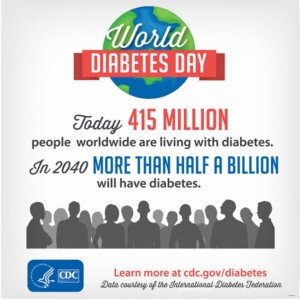
Seemingly overnight, the 20-something athlete with diabetes had both legs and an arm amputated.
Just three weeks prior he’d been on the beach playing high level volleyball. His stumps were raw; the amputations were very recent.
Just HOW can something so life-changing happen — especially to a young athlete?
So I asked a diabetes expert why in some patients, amputations can occur “overnight.”
“Typically, limbs don’t get amputated overnight unless there is some type of acute trauma,” says Alison Massey, MS, RD, LDN, registered dietitian and certified diabetes educator with over 10 years of experience in various community and clinical settings.
“Unfortunately, some of our patients with diabetes don’t manage it very well and develop complications that ultimately result in amputations.
“It is typically a process that happens over a period of time and is not sudden.
That is why we push for diabetes education and helping individuals manage their diabetes because if it is not managed well it can result in terrible complications.”
Infected sores in the feet can creep up on a diabetic, ultimately leading to the need for an amputation.
It’s mind boggling how these sores can sneak up on the patient, unnoticed – even though the patient may have what’s called diabetic neuropathy, which can mask the pain of any sores or wounds on the feet.
But must the patient FEEL the sores to know they’re there? What about visually checking their feet every day?
Here’s how infected sores can creep up on a diabetic and eventually lead to a need for a limb amputation.
Symptoms of Diabetes
Limbs don’t have to be cut off if you know the warning signs and, if diagnosed, practice good management of this disease.
Symptoms include excessive thirst, urination and hunger; unintentional weight loss; unexplained fatigue and blurry vision.
Thin people are not immune to type 2 diabetes, for which obesity is a major risk factor.

Alison Massey has been working in the field of nutrition since 2010 helping individuals make sustainable changes to improve their health.
 Lorra Garrick has been covering medical, fitness and cybersecurity topics for many years, having written thousands of articles for print magazines and websites, including as a ghostwriter. She’s also a former ACE-certified personal trainer.
Lorra Garrick has been covering medical, fitness and cybersecurity topics for many years, having written thousands of articles for print magazines and websites, including as a ghostwriter. She’s also a former ACE-certified personal trainer.
.
Top image: cdc.gov
Can You Be too Old to Get Type 1 Diabetes? How Old Is too Old?
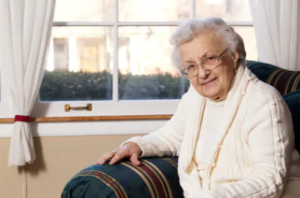
If you haven’t gotten type 1 diabetes by a certain age, does this mean you’ll never get this autoimmune disease, that you’re just too old to develop it? (more…)
Things Wrong with the Sinuses that Cause Headaches

All sorts of things can go on in the sinus cavities that can cause headaches, and you guess it:
Cancer is one of them. But do not confuse a severe headache with the “pressure” headache that infected sinuses so often cause. (more…)
Can Laryngeal Cancer Cause Ear Pain & What’s It Feel Like?

Ear pain has many causes and unfortunately one of them is laryngeal cancer.
Ear pain is a very common symptom and can present itself in different ways.
How might laryngeal cancer cause ear pain?
“The larynx, both for motor and sensory function, is innervated by the 10th cranial nerve, a.k.a. the vagus nerve,” says Dr. Stacey Silvers, MD, of Madison ENT & Facial Plastic Surgery in NYC, who is board certified in otolaryngology; one of her specialties is sinus surgery.
“There is a branch of the nerve called Arnold’s nerve which innervates (goes to) the ear,” continues Dr. Silvers.
“Diseases like laryngeal cancer, acid reflux and other inflammatory processes of the larynx, as a result, can cause ear pain. With cancer the pain is usually one-sided, as the tumor starts on one side.”
What does the ear pain of laryngeal cancer feel like?
“Eat pain from laryngeal cancer is fortunately not common,” says Dr. Silvers. “Patients describe it as a constant ache which can fluctuate in severity, which usually will not come and go, as tumors are progressive.”
Benign Conditions that Cause an Ear Pain Similar to Laryngeal Cancer’s
Dr. Silvers says, “TMJ, ear infections and Eustachian tube congestion can cause similar and often constant pain while their cause persists.
“But since TMJ and ear congestion fluctuates, the ear pain can too.”
TMJ refers to the temporomandibular joint of the jaw.
The odds of your ear pain being caused by laryngeal cancer are exceedingly low.
Here are the statistics on how many people a year, in various age brackets, are diagnosed with larynx cancer in the United States.
 An NYC expert in ear, nose and throat care, Dr. Silvers has been named among America’s Top Physicians and Surgeons in facial plastic surgery and otolaryngology numerous times since 2003. Dr. Silvers is an expert in the field of minimally invasive rhinology, resolving patients’ breathing and sinus problems with simple in-office procedures.
An NYC expert in ear, nose and throat care, Dr. Silvers has been named among America’s Top Physicians and Surgeons in facial plastic surgery and otolaryngology numerous times since 2003. Dr. Silvers is an expert in the field of minimally invasive rhinology, resolving patients’ breathing and sinus problems with simple in-office procedures.
 Lorra Garrick has been covering medical, fitness and cybersecurity topics for many years, having written thousands of articles for print magazines and websites, including as a ghostwriter. She’s also a former ACE-certified personal trainer.
Lorra Garrick has been covering medical, fitness and cybersecurity topics for many years, having written thousands of articles for print magazines and websites, including as a ghostwriter. She’s also a former ACE-certified personal trainer.
Top image: Shutterstock/aleks333
Can Sinusitis Cause Epiphora (Watering) in Only One Eye?

If you’ve read that epiphora in one eye can be caused by a sinus tumor, you’re certainly hoping that it’s just benign sinusitis causing all the watering in that one eye.
Epiphora in just one eye is, obviously, more alarming than excess watering that simultaneously affects both eyes. (more…)
Can Cancer Cause Asymmetrical or Uneven Adam’s Apple?

Two kinds of cancer can cause the Adam’s apple to appear asymmetrical or uneven.
If you’ve noticed this lately, you’ll want to be on the lookout for other symptoms that may develop that are possibly connected to this observation.
How does cancer cause an uneven or asymmetrical Adam’s apple?

Shutterstock/Mykola Samoilenko
“The thyroid rests over the thyroid cartilage (Adam’s apple),” says Dr. Stacey Silvers, MD, of Madison ENT & Facial Plastic Surgery in NYC, who is board certified in otolaryngology; one of her specialties is sinus surgery.
Dr. Silvers explains, “Tumors in the thyroid gland, benign or malignant, are one-sided and can give an obvious asymmetry.
“Tumors within the larynx [voice box] themselves, if large enough, can affect the cartilage externally.”
So the Adam’s apple itself isn’t what’s asymmetrical or uneven.
Rather, a benign or malignant growth distorts the shape of the normally symmetrical cartilage.
Should you panic over the discovery of this appearance?
Well, the big question is this:
Do you have other concerning symptoms, or is this your only “symptom”?
Dr. Silvers says, “But due to airway compromise and severe voice loss, diagnosis would usually be made prior to obvious external changes in the thyroid cartilage.”
If you’ve noticed that your Adam’s apple is not symmetrical, but
1) You have no other throat related symptoms, and
2) You don’t notice a progression with the appearance, then rest easy—it’s probably something that’s always been there—something you’ve never really noticed before.
Symptoms of Thyroid Cancer
• A new lump that you can feel on your neck
• Voice changes like hoarseness that won’t go away
• Trouble swallowing
• Throat or neck pain
• Swollen lymph nodes in the neck
Symptoms of Laryngeal Cancer
• Cough that won’t go away
• Voice changes including hoarseness that persist
• Trouble swallowing
• Lump in throat that won’t go away
• Ear pain
• Sore throat
• Unexplained weight loss
However, anxiety can cause the following:
• Perceived difficulty with swallowing
• Sensation of a lump in the throat
• Cough (from stress-induced acid reflux that makes its way to the vocal cords, even if there’s no feeling of heartburn)
Do not obsess over studying in a mirror an apparent asymmetry with your Adam’s apple.
Have an ear, nose and throat doctor check things out if you develop additional symptoms.
 An NYC expert in ear, nose and throat care, Dr. Silvers has been named among America’s Top Physicians and Surgeons in facial plastic surgery and otolaryngology numerous times since 2003. Dr. Silvers is an expert in the field of minimally invasive rhinology, resolving patients’ breathing and sinus problems with simple in-office procedures.
An NYC expert in ear, nose and throat care, Dr. Silvers has been named among America’s Top Physicians and Surgeons in facial plastic surgery and otolaryngology numerous times since 2003. Dr. Silvers is an expert in the field of minimally invasive rhinology, resolving patients’ breathing and sinus problems with simple in-office procedures.
 Lorra Garrick has been covering medical, fitness and cybersecurity topics for many years, having written thousands of articles for print magazines and websites, including as a ghostwriter. She’s also a former ACE-certified personal trainer.
Lorra Garrick has been covering medical, fitness and cybersecurity topics for many years, having written thousands of articles for print magazines and websites, including as a ghostwriter. She’s also a former ACE-certified personal trainer.
Top image: Shutterstock/litts
Sources:
mayoclinic.org/diseases-conditions/thyroid-cancer/basics/symptoms/con-20043551
mayoclinic.org/diseases-conditions/oral-and-throat-cancer/basics/symptoms/con-20042850
Why Are Medical Miracles Limited to Only Certain Conditions?
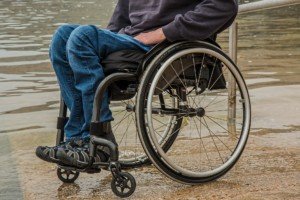
If medical miracles exist, why don’t they happen with all diseases and types of injury, rather than just a select few such as cancer and coming out of a coma?
Why don’t we see amputees growing limbs back, Alzheimer’s disease disappearing, ALS reversing and severely burned skin turning normal? (more…)
Spanking vs. Hitting vs. Whipping Your Child: the Difference?

Why do advocates of corporal punishment call it “spanking” when they probably BEAT their children?
Because they know that the term “spanking” softens the perception of hitting children. (more…)

